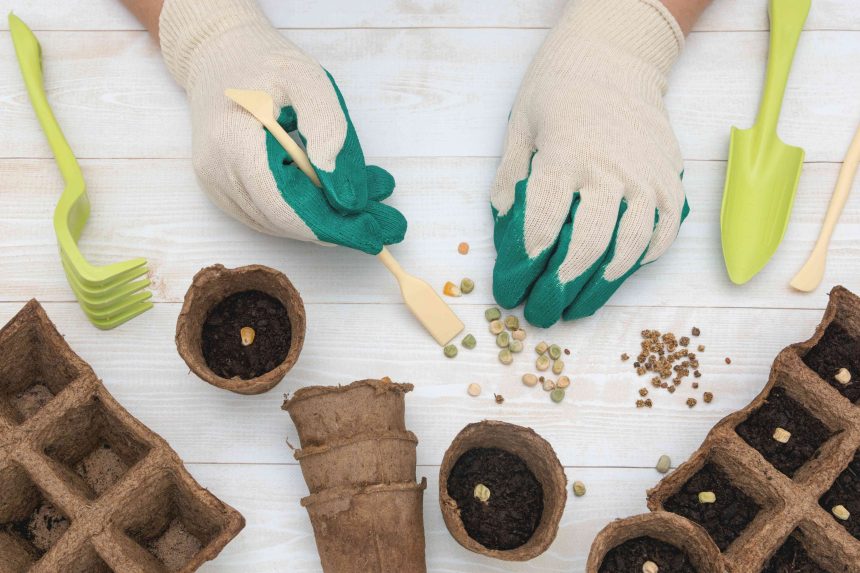When it comes to starting seeds successfully, there’s probably a bit of skill involved, some knowledge, some random chance, and an unknown amount of luck. Different kinds of seeds need different starting methods, however, there are some dos and don’ts that most gardeners would agree on.
We spoke to some gardening pros about what the worst seed starting tips are and what to do instead.
Meet the Expert
- Annette Hird is an expert gardener who writes about horticulture for Easy Urban Gardens.
- Mary Jane Duford is a master gardener and founder of Home for the Harvest.
- Kim Zimmerman is a master gardener and owner of Rowdy Poppy, a floral design house and micro-farm.
Using Ordinary Garden Soil to Start Seeds
Possibly a thrifty gardener somewhere along the way didn’t want to purchase extra seed starting mix, but many seeds need a suitable growing medium, and ordinary garden soil isn’t always a good choice. Garden soil can often be too heavy for effective seed starting.
Mary Jane Duford, a master gardener and founder of Home for the Harvest, explains how undesirable components can actually hinder germination, such as pests and pathogens (including fungi). They can cause disease or even kill tender seedlings as soon as they sprout.
Duford recommends using a sterile seed-starting mix that is lightweight, well-draining, and free from contaminants to give your seeds a good start. Annette Hird, an expert gardener who writes for Easy Urban Gardens, says she often makes her own seed starting mix using coco coir and vermiculite in equal amounts.
Want more gardening tips? Sign up for our free gardening newsletter for our best-growing tips, troubleshooting hacks, and more!
Putting Seed Trays in a Sunny Windowsill
Even if you think the sunlight coming through your window in winter is bright enough to get seeds to germinate, it probably isn’t. Duford explains how although modern windows are great at filtering light, they’re not ideal for starting seeds. She recommends using grow lights, placed about three inches above seedlings for 12-16 hours per day.
Kim Zimmerman, a master gardener and owner of Rowdy Poppy, also agrees that putting seed trays on a windowsill is bad advice. Insufficient light can cause the seedlings to stretch towards the sun and get long and leggy, which weakens them. She also points out that a cold drafty window can also stress seedlings due to temperature fluctuations in winter.
Starting All Your Seeds Indoors
Before engaging in seed starting activities, it’s always a good idea to check the specific needs of what you’re planting. Duford suggests doing some research starting with the seed packet.
“Some plants, like carrots, beets, and beans, do not like being transplanted and often perform poorly when moved,” Duford says.
Some seeds can and should be directly sown outdoors as soon as temperatures permit.
Using Moist Paper Towels in the Fridge
This can be good advice for certain kinds of seeds that benefit from cold stratification. But many seeds will germinate just fine using a moistened soil starter mix. Zimmerman explains that forcing seeds to germinate using the paper towel method can cause them unneeded stress, which is then compounded when the seeds are transplanted.
“I’ve seen so many seedling failures happen because of this,” Zimmerman says.
Zimmerman instead recommends using soil starter mix for plants that are weakened by root disturbance when germinating (like poppies).
Starting Too Early
Timing can be very important for seed starting, and again this is a good reason to do your research before planting. Duford says that starting seeds too early means that seedlings may get root bound or too big for their containers before it’s warm enough to transplant them outside. Moving them into bigger containers is an option if you have greenhouse space, but not everyone does.
“Use historical temperature data to estimate when you can plant your seedlings outdoors, and count backward to decide when to plant your seeds indoors,” Duford says.
She also says most seeds should be started approximately four to eight weeks prior to planting them outside.
Buying Bigger Containers to Produce Stronger Seedlings
There’s a reason seed-starting containers have such small compartments, and why cardboard egg cartons are often used to start seeds indoors. This partly has to do with water absorption.
Duford points out that larger containers hold more water than small ones, which means a seedling’s roots will take a lot of time to absorb all that water. Too much consistent moisture can cause root rot and reduce proper air circulation in the soil. She recommends starting with smaller seed trays with one-inch cells and transplanting into larger ones when necessary.






